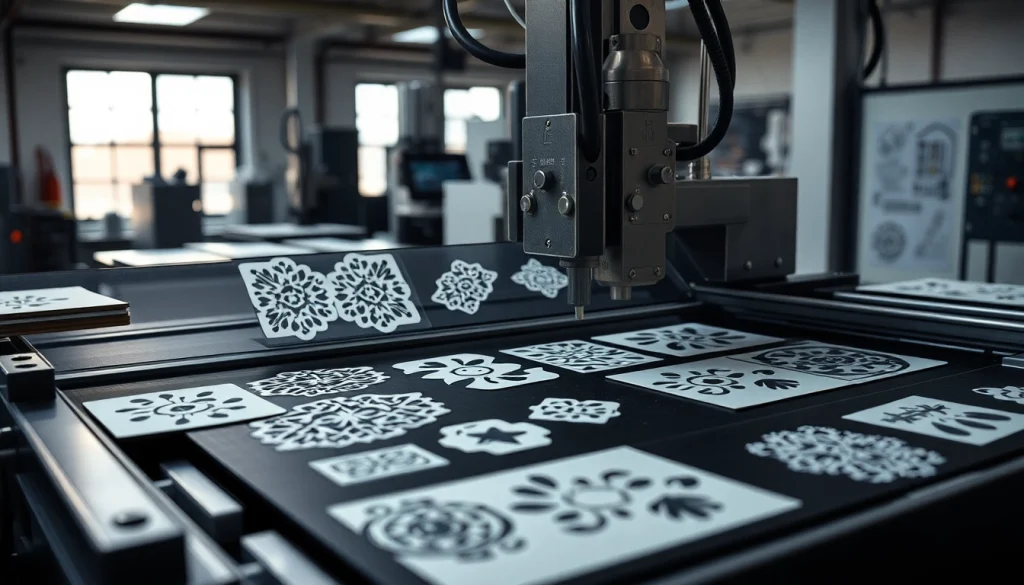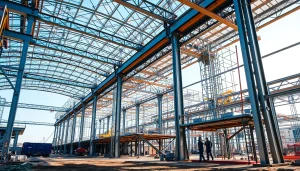Understanding Precision Die Cutting
What is Precision Die Cutting?
Precision die cutting is a manufacturing process used to produce parts and shapes from a variety of materials with immense accuracy. Utilizing sharp blades formed into specific shapes or outlines, this process enables manufacturers to create intricate and complex designs from different materials such as paper, plastic, rubber, and metal. The term ‘precision’ indicates that the die cutting process achieves extremely tight tolerances, which are critical in industries like automotive, aerospace, and medical manufacturing where even the slightest deviation can lead to failure or malfunction.
This technique often involves two primary methods: rotary die cutting and flatbed die cutting. While both techniques produce similar results, the choice between them depends on production volume, the complexity of the design, and the type of materials involved. The accuracy and efficiency of precision die cutting make it an indispensable service in modern manufacturing.
Key Benefits of Precision Die Cutting
- High Accuracy: With tolerances often within ±0.005 inches, precision die cutting ensures that all parts meet stringent specifications, which is essential for components that require seamless assembly.
- Versatility: This process can handle a wide range of materials, including flexible films, thick foams, metals, and intricate patterns, making it suitable for various industries.
- Cost Efficiency: Once the die is created, producing large volumes becomes cost-effective, with lower per-unit costs compared to other cutting methods.
- Speed: Precision die cutting can rapidly produce large quantities of parts, making it an ideal solution for high-volume production scenarios.
- Minimal Waste: The process is designed to maximize material usage, reducing scrap and inefficiency.
Common Applications of Precision Die Cutting
Precision die cutting finds applications across numerous industries. Some common applications include:
- Automotive: Creating seals, gaskets, and insulation materials that must fit precisely in vehicle assemblies.
- Medical: Producing components such as wound dressings, sterilization pouches, and other medical device parts with stringent hygiene and tolerance standards.
- Electronics: Manufacturing insulation and protection layers for circuit boards and electronic parts.
- Packaging: Crafting custom-shaped boxes and inserts that enhance product protection and aesthetic appeal.
- Textiles: Cutting complex patterns for clothing or upholstery, often used in bulk manufacturing runs.
The Process of Precision Die Cutting
How Precision Die Cutting Works
The precision die cutting process begins with the creation of a die, which is a specialized tool designed to cut a material into a specific shape. This die is typically made from steel or carbide and is constructed based on the desired final part specifications. Once the die is ready, it is mounted onto a cutting machine.
Materials are fed into the machine, where the die presses down firmly and cuts through the material to produce the required shapes. Depending on the complexity of the design and the thickness of the material, the process may vary slightly. For instance, rotary die cutting employs a cylindrical die that continuously cuts in a circular motion, while flatbed die cutting utilizes a stationary flatbed to cut each shape individually.
Types of Precision Die Cutting Techniques
There are several techniques employed within precision die cutting, each with its own strengths and intended applications:
- Rotary Die Cutting: This technique is well-suited for high-volume production runs, allowing for continuous feed and faster cutting speeds. It is ideal for soft and flexible materials.
- Flatbed Die Cutting: Commonly used for thicker materials, this method is advantageous for complex shapes and detailed designs, but it can be slower than rotary die cutting.
- Laser Cutting: Integrated into some precision die cutting processes, laser cutting offers incredible precision, especially for intricate patterns or designs and is often used in specialized applications.
- Water Jet Cutting: While less common in die cutting, this method can cut through hard materials without generating heat, making it useful for sensitive components.
Material Considerations for Precision Die Cutting
Choosing the right material is fundamental to the success of precision die cutting. Factors such as thickness, flexibility, and the intended application define the optimal material selection. Common materials used include:
- Foams: Used in cushioning and insulation applications, foams require precise cuts to achieve desired shapes and thicknesses.
- Adhesives: Die cutting adhesive-backed materials allows for streamlined manufacturing processes, particularly in electronics and automotive sectors.
- Papers and Plastics: These are extensively used in packaging and branding, requiring precise cuts for aesthetics and branding purposes.
- Metals: Thin metal sheets can be processed using die cutting techniques, making them suitable for electronic components and automotive parts.
Factors Influencing Precision in Die Cutting
Tolerances in Precision Die Cutting
Tolerances refer to the allowable deviation from a specified dimension. In precision die cutting, maintaining tight tolerances is essential for ensuring that parts fit and function as intended. Typical tolerances depend on the material and cutting method used; for example, steel rule dies can achieve tolerances of ±0.005 inches. Understanding these limits allows manufacturers to design parts that fit together seamlessly, prevent malfunctions, and enhance overall product quality.
Common Challenges in Maintaining Precision
While precision die cutting offers numerous benefits, manufacturers often face challenges in maintaining the desired level of accuracy:
- Wear and Tear of Dies: Ongoing use of dies can lead to degradation, requiring maintenance or replacement that can disrupt production.
- Material Variability: Differences in material thickness, composition, or moisture content can affect the cutting performance and final results.
- Machine Calibration: Ensuring that cutting machines are consistently recalibrated is essential to maintain precision over time.
- Design Complexity: More complex designs may require additional setup, making it challenging to maintain high throughput while ensuring precision.
Measuring Success: Metrics for Precision Die Cutting
To measure the success of precision die cutting operations, it’s essential to track key performance indicators (KPIs). These include:
- Part Quality: Evaluating the accuracy and consistency of die cut parts against design specifications.
- Production Speed: Measuring the throughput or speed of production to ensure efficiency.
- Material Utilization: Analyzing the waste produced during the die cutting process to optimize material usage.
- Cost-Effectiveness: Assessing the cost of die production versus the lifetime yield and efficiency of the components produced.
Choosing the Right Precision Die Cutting Provider
What to Look for in a Precision Die Cutting Company
When seeking a precision die cutting service provider, several factors should be considered to ensure a successful partnership:
- Experience and Expertise: Look for companies with a proven track record in precision die cutting across various industries.
- Technology and Equipment: Invest in companies that utilize the latest technologies, including advanced die cutting machinery and software, to enhance precision.
- Quality Assurance: Ensure the provider has robust quality control measures to maintain high standards of part production.
- Custom Solutions: A versatile company that can tailor solutions to meet unique project requirements adds value to your product development.
Questions to Ask Potential Die Cutting Vendors
Before finalizing a contract with a precision die cutting provider, consider asking the following important questions:
- What materials do you specialize in cutting?
- Can you provide examples of previous projects that similar to mine?
- What are your typical lead times and production capacities?
- How do you ensure consistency and with what quality control measures?
- What certification or standards do you adhere to in your manufacturing process?
Evaluating Quality and Costs in Precision Die Cutting
Lastly, performing a thorough evaluation of quality versus cost is crucial. While lower costs can be attractive, it’s essential to ensure that quality does not suffer. Look for companies that offer a balance between pricing, quality assurance, and customer service. It’s also beneficial to request samples or small runs to assess part quality before committing to larger orders.
Future Trends in Precision Die Cutting
Innovations Driving Precision Die Cutting Forward
As technology continues to advance, precision die cutting is also evolving. Innovations in design software, automation, and manufacturing techniques are shaping the future of this process.
One significant trend is the integration of automation and manufacturing execution systems (MES), which allow for real-time tracking and data analysis of production metrics. This smart technology can optimize processes, reduce downtime, and enhance overall efficiency.
The Role of Technology in Enhancing Precision
Technologies such as laser cutting and computer numerical control (CNC) machining are set to complement traditional die cutting methods, allowing providers to achieve unparalleled precision in their operations. These technologies can produce complex shapes and integrate processes like engraving or etching, further expanding the capabilities of precision die cutting services.
Emerging Markets for Precision Die Cutting Services
With industries like renewable energy, biotechnology, and electronics on the rise, new markets are opening up for precision die cutting services. Manufacturers in these sectors are increasingly seeking high-precision components that adhere to stringent safety and reliability standards. Thus, diversifying offerings to include components for these sectors may lead to new business opportunities for die cutting providers.








